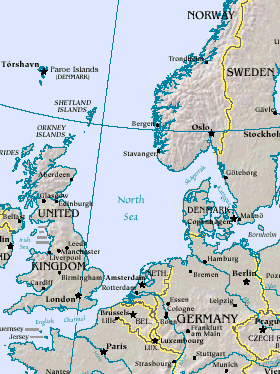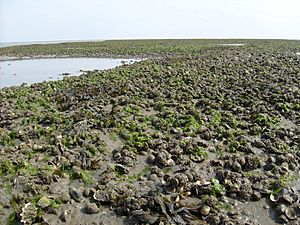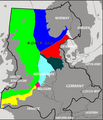North Sea facts for kids
The North Sea is a sea in northern Europe. It is part of the Atlantic ocean. The North Sea is between Norway and Denmark in the east, Scotland and England in the west, Germany, the Netherlands, Belgium and France in the south.
Contents
Borders
The Skagerrak connects the North Sea to the Baltic Sea. In the south, the North Sea becomes the English Channel, a sea between England and France. This is called the Dover Straits and is very busy with ships.
The border between the North Sea and the Skagerrak is at an imagined line between Lindesnes in Norway, and Hanstholm in Denmark. In the North, the North sea is open towards the Atlantic. The border between the two is an imagined line from Northern Scotland, to the Shetlands, and then to Ålesund in Norway. According to the Oslo-Paris Treaty of 1962 it is a bit more to the west and the north though. The treaty puts it at 5° East longitude, and 62° North latitude. That is at the parallel of the Geirangerfjord in Norway.
Various statistical data
On average, the North Sea has a depth of only 94 metres. About 80 million people live near the North Sea, at most 150 km away from the coast. Together with the English Channel in the south, the southern North Sea is the busiest body of water in the world.
Rivers that drain into it
Well-known rivers that drain into the North Sea include the Tay (at Dundee), the Forth (at Edinburgh), the Tyne (South Shields), the Wear (at Sunderland), the Tees (near Middlesbrough), the Elbe (at Cuxhaven), the Weser (at Bremerhaven), the Rhine and Meuse or Maas (at Rotterdam), the Scheldt (at Flushing or Vlissingen), the Thames, and the Humber (at Hull).
The Kiel Canal, one of the world's busiest artificial waterways, connects the North Sea with the Baltic.
Name
Its name comes from its relationship to the land of the Frisians (see Frisia). They live directly to the south of the North Sea, and to the west of the East Sea (Oostzee, the Baltic Sea), the former South Sea (Zuiderzee, today's IJsselmeer) and the today reclaimed Middle Sea (Middelzee). But the spread of the name could also be from the view of the cities of the Hanseatic League. Some of its main cities, like Lübeck, Bremen or Hamburg had the same view.
In classical times this body of water was also called the Oceanum Germanicum or Mare Germanicum, meaning German Ocean or Sea. This name was commonly used in English and other languages along with the name North Sea, until the early eighteenth century. By the late nineteenth century, German Sea was a rare, scholarly usage even in Germany. In Danish the North Sea is also named Vesterhavet (besides Nordsøen), meaning Western Ocean because it is west of Denmark.
Geographic divisions
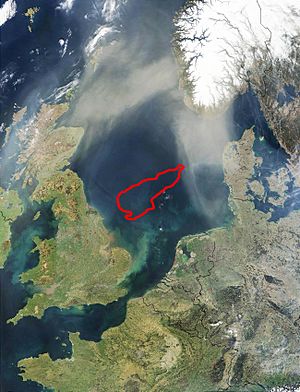
Most of the North sea is on the European Continental shelf. On average, the depth is about 93 to 94 meters only. In the south it is very shallow, only 25 to 35 meters. In the north in the bathyal zone north of the Shetlands, this depth increases to between 100 and 200 metres. In the south, the depth is at most 50 metres. An exception to this is the Norwegian Trench. It is deepest there, with a depth of 725 metres. The most shallow part of it is a sand bank called Dogger Bank. In the southern part, there are many sand banks.
Looking at the satellite picture it is easy to see the geographic divisions of the North Sea:
- a generally shallow southern North Sea
- the central North Sea
- the northern North Sea, with the Norwegian Trench, near the Skagerrak.
The southern north sea is composed of the Southern Bight, before the coast of Belgium and the Netherlands and the German Bight before the coastline of Germany. The Dogger Bank is the limit between the southern and central parts. The Waddenzee runs all the way from Den Helder in the Netherlands to Esbjerg in Denmark.
The Dogger Bank covers an area about half the size of the Netherlands. There, the North Sea has a depth of between 13 and 20 metres only. The area is very famous for fishing. With some storms there are even waves breaking there.
The Norwegian Trench has an average depth of around 250 to 300 metres; at the entrance to the Skagerrak, the depth increases up to 725 meters. Along the trench is the Norwegian Current, which brings most of the waters of the North Sea into the Atlantic ocean. Also, most of the waters of the Baltic Sea flow northwards here.
About 200 km east of the Scottish city of Dundee there are more trenches, known collectively as the Devil's hole. Generally, the water is about 90 meters deep there. The trenches very often are only a few kilometers in length. In these trenches, the depth increases to up to 230 meters.
In the Dover Strait the water is about 30 meters deep. At the end of the English Channel, this depth increases to about 100 meters.
History
In the last ice age the North Sea was covered by large areas of ice called glaciers. About 20,000 years ago the ice melted and the North Sea was formed (made).
North Sea oil
In the 1960s geologists found large areas of oil and natural gas under the North Sea. Most of the oil fields are owned by the United Kingdom and Norway but some belong to Denmark, the Netherlands and Germany. Drilling began in the 1960s and led to a famous argument between England and Scotland about how the revenue (money) from the oil should be spent.
Nature
Fish and shellfish
Copepods and other zooplankton are plentiful in the North Sea. These tiny organisms are crucial elements of the food chain supporting many species of fish. Over 230 species of fish live in the North Sea. Cod, haddock, whiting, saithe, plaice, sole, mackerel, herring, pouting, sprat, and sandeel are all very common and are fished commercially. Due to the various depths of the North Sea trenches and differences in salinity, temperature, and water movement, some fish such as blue-mouth redfish and rabbitfish reside only in small areas of the North Sea.
Crustaceans are also commonly found throughout the sea. Norway lobster, deep-water prawns, and brown shrimp are all commercially fished, but other species of lobster, shrimp, oyster, mussels and clams all live in the North Sea. Recently non-indigenous species have become established including the Pacific oyster and Atlantic jackknife clam.
Birds
The coasts of the North Sea are home to nature reserves including the Ythan Estuary, Fowlsheugh Nature Preserve, and Farne Islands in the UK and the Wadden Sea National Parks in Denmark, Germany and the Netherlands. These locations provide breeding habitat for dozens of bird species. Tens of millions of birds make use of the North Sea for breeding, feeding, or migratory stopovers every year. Populations of black legged kittiwakes, Atlantic puffins, northern fulmars, and species of petrels, gannets, seaducks, loons (divers), cormorants, gulls, auks, and terns, and many other seabirds make these coasts popular for birdwatching.
Marine mammals
The North Sea is also home to marine mammals. Common seals, and harbour porpoises can be found along the coasts, at marine installations, and on islands. The very northern North Sea islands such as the Shetland Islands are occasionally home to a larger variety of pinnipeds including bearded, harp, hooded and ringed seals, and even walrus. North Sea cetaceans include various porpoise, dolphin and whale species.
Flora
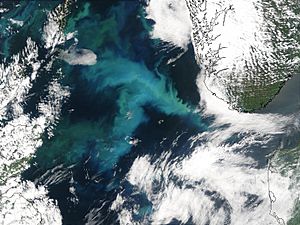
Plant species in the North Sea include species of wrack, among them bladder wrack, knotted wrack, and serrated wrack. Algae, macroalgal, and kelp, such as oarweed and laminaria hyperboria, and species of maerl are found as well. Eelgrass, formerly common in the entirety of the Wadden Sea, was nearly wiped out in the 20th century by a disease. Similarly, sea grass used to coat huge tracts of ocean floor, but have been damaged by trawling and dredging have diminished its habitat and prevented its return. Invasive Japanese seaweed has spread along the shores of the sea clogging harbours and inlets and has become a nuisance.
Images for kids
-
Ocean currents mainly entering via the north entrance exiting along the Norwegian coast
-
• Localization of the tide-gauges listed • Tide times after Bergen (negative = before) • The three amphidromic centers • Coasts: marshes = green mudflats = greenish blue lagoons = bright blue dunes = yellow sea dikes= purple moraines near the coast= light brown rock-based coasts = greyish brown
-
Zuid-Beveland, North Sea flood of 1953
-
Painting of the Four Days' Battle of 1666 by Willem van de Velde the Younger
-
German cruiser SMS Blücher sinks in the Battle of Dogger Bank on 25 January 1915.
-
The exclusive economic zones in the North Sea
-
Unpolished amber stones, in varying hues
-
Rotterdam, Netherlands
-
A 1482 recreation of a map from Ptolemy's Geography showing the "Oceanus Germanicus"
-
Edmond Halley's solar eclipse 1715 map showing The German Sea
See also
 In Spanish: Mar del Norte para niños
In Spanish: Mar del Norte para niños


